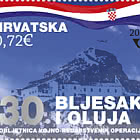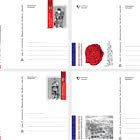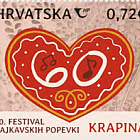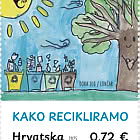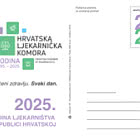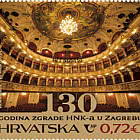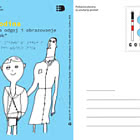Croatian Fine Art
Hugo Conrad von Hötzendorf, Landscape, 1867 (oil on canvas, 70 cm x 99 cm), Modern Gallery, Zagreb (Inventory No.: MG-2141)
Hugo Conrad von Hötzendorf (?, around 1807 – Osijek, 1869), painter and pedagogist, one of the most significant 19th-century painters from Osijek. He learned how to paint alongside his father, who was a teacher at a drawing school in Osijek. Between 1836 and 1838, he received private education in Vienna. After his father’s death in 1841, he took over his position at the drawing school. He was an extremely talented pedagogist and numerous painters from Osijek received their first lessons from him. Among those painters was the young Izidor Kršnjavi, who later stated that he had never had a better teacher than Hötzendorf. A few years before his death, he also established a private painting school in Osijek.
Hötzendorf's artistic style was similar to that of Romantic painters from Vienna. His earlier works were predominantly realistic, while his later works were more of an idealistic and romantic interpretation of nature. His paintings included landscapes, pastoral scenes, genre painting of hunting scenery, portrayals of peasants in traditional clothing and old town ruins. Besides oil painting, he also painted in watercolour and was very talented in drawing, which is particularly evident from his numerous drawings of ruins in Slavonia. He often travelled through Slavonia, Srijem, Carinthia and Gorski Kotar, seeking motifs for his paintings. Due to his extraordinary sense for the effects of light and his attention to detail, his works represent one of the most significant landscape art collections in Croatian 19th-century painting.
The oil painting Landscape(1867) is representative of Hötzendorf’s later work. This painting represents all his painting talents: a skilful composition, a romantic attitude towards ruins of architectural monuments, a detailed landscape (from undergrowth in the forefront to the monumental tree in the centre of the composition and a refined use of light. All these elements create a qualitative distinction between Hötzendorf and other Croatian painters of his time.
Vjekoslav Karas, Portrait of a Girl, 1857 (oil on canvas, 118.5 cm x 92.5 cm), Modern Gallery, Zagreb (Inventory No.: MG-75)
The life and work of Vjekoslav Karas (Karlovac, 1821 – Karlovac, 1858.) will be remembered as a special part of the story about Croatian art and the broader cultural history, mostly due the painter’s interesting, but tragic life story. He was the only painter of this period who came from the northern parts of Croatia and who, thanks to financial resources granted to him by several patrons from Karlovac and Zagreb, received his education in Rome. He started studying painting in modest surroundings, at the workshops of painters and craftsmen from Karlovac. He continued his studies in Florence (1838 – 1841) and after spending a few months in Siena, he eventually studied in Rome, where he lived between 1841 and 1847. The following year he returned to Karlovac due to poverty and lack of financial support. For a brief time he worked as a teacher at a drawing school in Zagreb, after which he left for Bosnia. From 1852 until his death, he lived in Karlovac and Zagreb, poor and dissatisfied with the lack of commissions for artwork. He committed suicide by jumping into the river Korana.
His opus is not extensive and it is not uniform in terms of quality. Nevertheless, it is a testimony of an exceptional artistic talent. Moving “between styles” (G. Gamulin), the painter first painted under the influence of the Nazarene movement, which was followed by an attempt of creating his own style based on neoclassical, romantic and Biedermeier influences. He painted Biblical scenes, portraits of citizens, scenes from the life of ordinary people and historical compositions. His paintings were rarely signed and dated. He is the author of several masterpieces of the Croatian 19th-century paintings, most famous of which are: Roman Woman Playing a Mandolin/Lute(Croatian History Museum, Zagreb), painted during his time spent in Rome, between 1845 and 1847.
The painting Portrait of a Girl (with doll and dog)from 1857, the last known Karas’ work, was made in Đakovo, where he came to live at the invitation of Josip Juraj Strossmayer, shortly before he died. It is a portrait in a relatively conventional form, dominated by vivid colours of the background, bed and drapery and with an interesting element of landscape visible through an open window. This painting, as the final chapter of the artist’s work, is a testimony of Karas’ talent, attention to details and attempt to create a specific artistic language in the formative period of Croatian national culture.
Jozo Kljaković, Fishermen(Return of the Fishermen), 1935 (oil on canvas, 100 cm x 130 cm), Modern Gallery, Zagreb (Inventory No.:MG-846)
The formative path of painter and pedagogist Jozo Kljaković (Solin, 1889 - Zagreb, 1969) was very rich and characterised by diversity. He first studied from Vlaho Bukovac in Prague (1908), after which he continued his studies in Rome and finally at the studio of Ferdinand Hodler in Geneva (1917). He studied fresco painting at the Académie Ranson in Paris in 1920. From 1921 to 1943, he held the position of professor at the Academy of Fine Arts in Zagreb. He was imprisoned, together with Ivan Meštrović, by the Ustaša Croatian Revolutionary Movement at the end of 1941 and beginning of 1942, after which he left his homeland and spent the following twenty-five years living in Rome and Buenos Aires. He spent the last year of his life in Zagreb. The Jozo Kljaković Memorial Collection is housed in his family home at Rokov Perivoj in Zagreb.
In his artistic beginnings, he took to the Art Nouveau style of expression, influenced by Hodler and Meštrović’s symbolism, in which context he made a significant contribution to Croatian Art Nouveau corpus of artwork. Focused on the form of the figure, the value of the drawing and an intently balanced composition, Kljaković grew to become the most important representative of monumental Neoclassicism as a part of neorealistic tendencies in Croatian post-war painting. His works were mostly large paintings and his skill of figurative monumentalization was best reflected in numerous cycles of frescos (in St. Mark’s Church in Zagreb, St. Martin’s Church in Vranjic, St. Mary’s Church in Biskupija kod Knina and others) and in his mosaics on the facade of the building of Pontifical Croatian College of St. Jerome in Rome (1944 – 1961). He painted biblical compositions, Arcadian scenes and scenes from day-to-day lives of fishermen. His paintings were mostly oil paintings. He was an excellent caricature artist and illustrator and he also published a novel and a book of memoir prose.
His painting Return of the Fishermen(1935) is representative of Kljaković’s style of painting in mid 1930s. It shows a commonplace scene often observed in small towns on the coast: fishermen returning to the port with their catch, where they are awaited by townsfolk. Although one can notice a gradual softening of the previously distinctly hard modelling of objects and figures, which used to be at the core of Kljaković’s style by that point, the painting is still dominated by an interest in volume and thought-out composition, which lends the scene an impression of classical grandeur. By “monumentalizing his image of the world” (G. Gamulin), Kljaković approached the day-to-day lives of small towns on the Adriatic coast with particular attention, regarding them to be worthy of being presented in the same fashion as the grand art themes.
Petar Prelog
Senior Research Associate at the
Institute of Art History
Croatia - Recommended stamp issues
WOPA+ recommended stamp issues
| Avatar - Fire and Ash |
| Issued: 03.12.2025 |
| ›New Zealand |
| 50th Anniversary of the Founding of the 24th November Bar Scout |
| Issued: 24.11.2025 |
| ›Montenegro |
| Krisjanis Valdemars |
| Issued: 02.12.2025 |
| ›Latvia |
| Sign Language - Good |
| Issued: 02.12.2025 |
| ›Bosnia and Herzegovina - Republic of Srpska |
| In Memory of the Fallen and Murdered on October 7, 2023 |
| Issued: 08.10.2025 |
| ›Israel |
| Annual Collection Folder (New York) |
| Issued: 05.12.2025 |
| ›United Nations |
| Year Set |
| Issued: 24.11.2025 |
| ›Isle of Man |
| Shipping in the 17th and 18th Centuries - Peat Shipping |
| Issued: 05.12.2025 |
| ›Netherlands |









